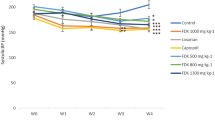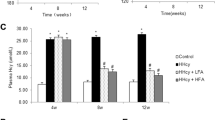Abstract
In spontaneously hypertensive rats (SHRs) excess endogenous aldehydes bind sulfhydryl groups of membrane proteins, altering membrane Ca2+ channels, increasing cytosolic free calcium and blood pressure. N-acetyl cysteine normalizes elevated blood pressure in SHRs by binding excess endogenous aldehydes. It is known that dietary vitamin B6 supplementation can increase the level of endogenous cysteine. Our objective was to investigate whether a dietary supplementation of vitamin B6 can prevent hypertension and associated changes in SHRs. Starting at 7 weeks of age, animals were divided into three groups of six animals each. Animals in WKY-control group and SHR-control group were given a normal vitamin B6 diet; and SHR-vitamin B6 group, a high vitamin B6 diet (20 times the recommended dietary intake; RDA) for the next 14 weeks. After 14 weeks, systolic blood pressure, platelet [Ca2+]i and liver, kidney and aortic aldehyde conjugates were significantly higher in SHR controls compared to WKY controls. These animals also showed smooth muscle cell hyperplasia in the small arteries and arterioles of the kidneys. Dietary vitamin B6 supplementation attenuated the increase in systolic blood pressure, tissue aldehyde conjugates and associated changes. These results further support the hypothesis that aldehydes are involved in increased systolic blood pressure in SHRs and suggest that vitamin B6 supplementation may be an effective antihypertensive.
Similar content being viewed by others
References
Schauenstein E, Esterbauer H, Zollner H: In: Aldehydes in biological systems, their natural occurrence and biological activities. Pion Limited, London, pp. 163–171, 1977
Schauenstein E, Esterbauer H: In: Submolecular biology and cancer. Excerpta Medica, CIBA Foundation Symposium, 67: 225–244, 1979
Vasdev S, Mian T, Ford CA, Longerich L, Parai S: Role of endogenous aldehydes in spontaneously hypertensive and disulfiram-induced hypertensive rats. Nutr Metab Cardiovasc Dis 6: 130–140, 1996
Vasdev S, Ford CA, Longerich L, Gadag V, Wadhawan S: Role of aldehydes in fructose induced hypertension. Mol Cell Biochem 181: 1–9, 1998
Lumeng L, Li T-K: Vitamin B6 metabolism in chronic alcohol abuse. J Clin Invest 53: 693–704, 1974
Lumeng L: The role of acetaldehyde in mediating the deleterious effect of ethanol on pyridoxal 5'-phosphate metabolism. J Clin Invest 62: 286–293, 1978
Lieber CS: Mechanism of ethanol induced hepatic injury. Pharmac Ther 46: 1–41, 1990
Sorrell MD, Ruma DJ: The functional implications of acetaldehyde binding to cell constituents. Annals NY Acad Sci 492: 50–70, 1987
Vasdev S, Barrett B, Longerich L, Ford CA: Ethanol-induced hypertension: The role of acetaldehyde. In: N.S. Dhalla (ed): Pathophysiology of Heart Failure. Kluwer Academic Publishers, Norwell, MA, pp. 77–93, 1996
Vasdev S, Longerich L, Ford CA: Role of aldehydes in hypertension. In: B.K. Sharma, N. Takeda, N.K. Ganguly, P.K. Singal (eds): Adaptation Biology and Medicine (Vol I). Narosa Publishing House, New Delhi, India pp. 326–339, 1997
Sprince H, Parker CM, Smith GG, Gonzales LJ: Protection against acetaldehyde toxicity in the rat by L-cysteine, thiamin and L-2-methylthiazolidine-4-carboxylic acid. Agents Actions 4: 125–129, 1974
Meister A, Anderson ME, Hwang O: Intracellular cysteine and glutathione delivery systems. J Am Col Nut 5: 137–151, 1986
Lehninger AL: Biochemistry: the molecular basis of cell structure and function, 2nd ed. Worth Publishers, Inc, New York, pp. 698, 1978
Smolin LA, Benevenga NJ: Accumulation of homocyst(e)ine in vitamin B-6 deficiency: A model for the study of cystathionine β-synthase deficiency. J Nutr 112: 1264–1272, 1982
Dillard CJ, Tappel AL: Fluorescent damage products of lipid peroxidation. Methods Enzymol 105: 337–341, 1984
Mandal AK, Bell RD, Parker D, Nordquist JA, Lindeman RD: An analysis of the relationship of the malignant lesions of the kidney to hypertension. Microvas Res 14: 279–292, 1977
Schauenstein E, Esterbauer H, Zollner H: Aldehydes in biological systems. In: J.R.. Lagnado (ed): Aldehydes in biological systems, their natural occurrence and biological activities. Pion Limited, Brondesbury Park, London pp. 1–7, 1977
Franco-Obregón A, Ureña J, López-Barneo J: Oxygen-sensitive calcium channels in vascular smooth muscle and their possible role in hypoxic arterial relaxation. Proc Natl Acad Sci 92: 4715–4719, 1995
Murphy BJ, Washkurak AW, Tuana BS: Dihydropyridine binding to the L-type Ca2+ channel in rabbit heart sarcolemma and skeletal muscle transverse-tubules: Role of disulfide, sulfhydryl and phosphate groups. Biochim Biophys Acta 1052: 333–339, 1990
Zaidi NF, Lagenaur CF, Abramson JJ, Pessah I, Salama G: Reactive disulfides trigger Ca2+ release from sarcoplasmic reticulum via an oxidation reaction. J Biol Chem 264: 21725–21736, 1989
Oba T, Yamaguchi M: Sulfhydryls on frog skeletal muscle membrane participate in contraction. Am J Physiol 259: C709–C714, 1990
Bolli P, Erne P, Hulthen UL, Ritz R, Kiowski W, Ji BH, Buhler FR: Parallel reduction of calcium-influx-dependent vasoconstriction and platelet-free calcium concentration with calcium entry and badrenoceptor blockade. J Cardiovasc Pharmac 6: S996–S1001, 1984
Pollard TD: Electron microscopy of synthetic myosin filaments. J Cell Biol 67: 93–104, 1975
Vasdev S, Ford CA, Longerich L, Parai S, Gadag V, Wadhawan S: Aldehyde induced hypertension in rats: prevention by N-acetyl cysteine. J Hypertens (submitted), 1998
Finkelstein JD, Chalmers FT: Pyridoxine effects on cystathionine synthase in rat liver. J Nutr 100: 467–469, 1970
Takeuchi F, Izuta S, Tsubouchi R, Shibata Y: Glutathione levels and related enzyme activities in vitamin B-6-deficient rats fed a high methionine and low cystine diet. J Nutr 121: 1366–1373, 1991
Mayes PA: Structure and function of the water-soluble vitamins. In: R.K. Murray, D.K. Granner, P.A. Mayers, V.W. Rodwell (eds): Harper's Biochemistry. Appleton and Lange, Stanford, Connecticut pp. 599–613, 1996
Aybak M, Sermet A, Ayyildiz MO, Karakilcik: Effect of oral pyridoxine hydrochloride supplementation on arterial blood pressure in patients with essential hypertension. Arzneimittel-forschung 45: 1271–1273, 1995
Lal KJ, Dakshinamurti K, Thliveris J: The effect of vitamin B6 on the systolic blood pressure of rats in various animal models of hypertension. J Hyperten 14: 355–363, 1996
Bennink HJTC, Schreurs WHP: Improvement of oral glucose tolerance in gestational diabetes by pyridoxine. Brit Med J 3: 13–15, 1975
Spellacy WN, Buhi WC, Birk SA: Vitamin B6 treatment of gestational diabetes mellitus. Am J Obst Gyn 127: 599–602, 1977
Reaven GM, Hoffman BB: Abnormalities of carbohydrate metabolism may play a role in the etiology and clinical course of hypertension. Tr Pharmacol Sci 9: 78–79, 1998
Thornalley PJ: Modification of the glyoxalase system in disease processes and prospects for therapeutic strategies. Biochem Soc Trans 21: 531–534, 1993
Vander Jagt DL, Hunsaker LA: Substrate specificity of reduced and oxidized forms of human aldose reductase. In: H.Y. Weiner (ed): Enzymology and Molecular Biology of Carbonyl Metabolism 4. Plenum Press, New York pp. 279–288, 1993
Leoncini G, Maresca M, Buzzi E: Inhibition of the glycolytic pathway of methylglyoxal in human platelets. Cell Biochem Function 7: 65–70, 1989
Takatsu T, Kashii C: Cardiac hypertension in spontaneously hypertensive rats. In: K. Okamoto (ed): Spontaneous Hypertension. Its Pathogenesis and Complications. Springer-Verlag, New York, pp. 166–172, 1972
Author information
Authors and Affiliations
Rights and permissions
About this article
Cite this article
Vaasdev, S., Ford, C., Parai, S. et al. Dietary vitamin B6 supplementation attenuates hypertension in spontaneously hypertensive rats. Mol Cell Biochem 200, 155–162 (1999). https://doi.org/10.1023/A:1007088512834
Issue Date:
DOI: https://doi.org/10.1023/A:1007088512834




